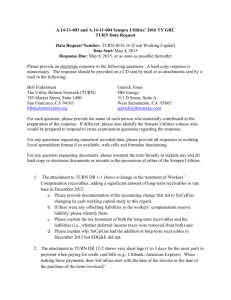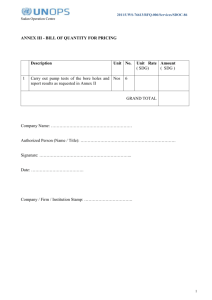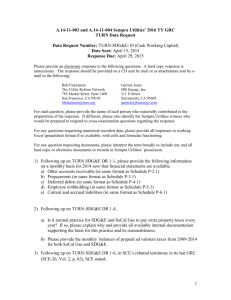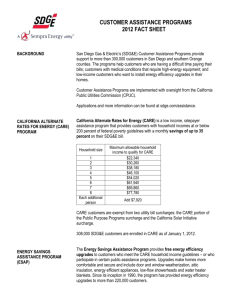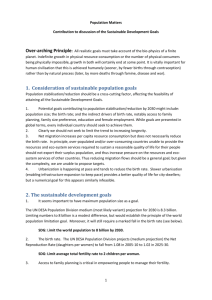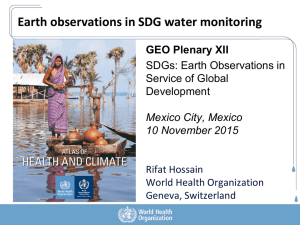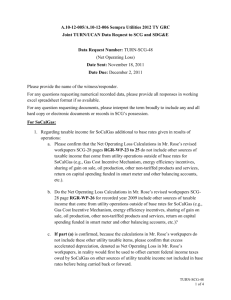The Water Energy Nexus - Bren School of Environmental Science
advertisement
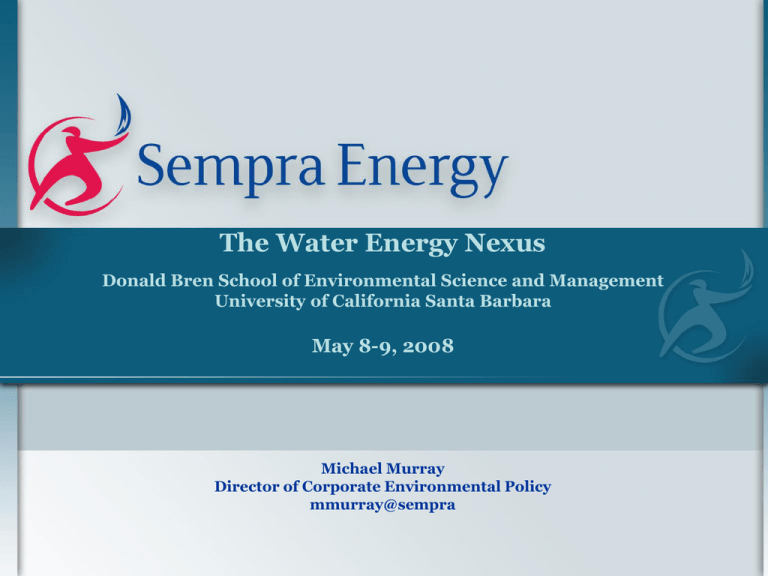
The Water Energy Nexus Donald Bren School of Environmental Science and Management University of California Santa Barbara May 8-9, 2008 Michael Murray Director of Corporate Environmental Policy mmurray@sempra California Utilities San Diego Gas & Electric Southern California Gas Natural Gas Infrastructure Global Commodities Sempra LNG Sempra Pipelines & Storage RBS Sempra Commodities Sempra Generation Page 1 Energy and Water Relationship Energy production requires water • Thermoelectric cooling • Hydropower Water production and distribution requires energy • Extraction and mining • Pumping • Fuel Production (H2, ethanol) • Transport • Emission controls • Treatment • Wastewater treatment Page 2 Diagram of Energy and Water Distribution Systems Page 3 Water, Energy and Climate Change Policy Intersection l Policy “Sweet Spot” Water Policy Energy Policy Carbon Change Policy Maximize Policy synergies by focusing on areas of overlap. Page 4 How Energy Impacts Water Quantity and Quality Energy Element Connection to Water Quantity Connection to Water Quality Energy Extraction and Production Oil and Gas Exploration Water for drilling, completion, and fracturing Impact on shallow groundwater quality Oil and Gas Production Large volume of produced, impaired water Produced water can impact surface and groundwater Coal and Uranium Mining Mining operations can generate large quantities of water Tailings and drainage can impact surface water and ground-water Electric Power Generation Thermoelectric (fossil, biomass, nuclear, solar thermal) Surface water and groundwater for cooling** and scrubbing Thermal and air emissions from impact surface waters and ecology Hydroelectric Reservoirs lose large quantities to evaporation Can impact water temperatures, quality, ecology Solar PV and Wind None during operation; minimal water use for panel and blade washing Page 5 How Energy Impacts Water Quantity and Quality Energy Element Connection to Water Quantity Connection to Water Quality Refining and Processing Traditional Oil and Gas Refining Water needed to refine oil and gas End use can impact water quality Biofuels and Ethanol Water for growing and refining Refinery wastewater treatment Synfuels and Hydrogen Water for synthesis or steam reforming Wastewater treatment Energy Transportation Energy Pipelines Water for hydrostatic testing Wastewater requires treatment Coal Slurry Pipelines Water for slurry transport; water not returned Final water is poor quality; requires treatment Barge Transport of Energy River flows and stages impact fuel delivery Spills or accidents can impact water quality Page 6 Water Intensity for Various Power Generation Technologies From a water use perspective natural gas combined cycle plants use less water than any other generation technology that uses cooling. Dry cooling (air) reduces water use, but increases carbon emissions and increases cost due to lost efficiency (up to 25% on hot dry days.) Source: Energy Demands of Water Resources; Report to Congress on the interdependency of Energy and Water, U.S. Department of Energy, December 2006; page 38. Page 7 Providing Water is an Energy Intensive Enterprise kWh/Million gallons Low High 0 16,000 100 1,500 700 1,200 Water Cycle Segments Supply and Conveyance Treatment Distribution Wastewater Collection and Treatment 1,100 Wastewater Discharge 0 TOTAL 1,900 4,600 400 23,700 Recycled Water Treatment and Distribution for Nonpotable Uses 1,200 Source: CEC 2005 400 • Significant Energy required to transport, treat, and distribute water (about 19% of state electricity use) • Costs varies significantly by local. –Generally, the greater the level of imported water, the greater the embedded energy in water. • Most water is in Northern California and must be moved south, often over mountains in a very energy intensive process. • >3500kwh per acre foot to deliver water to So Cal. Page 8 Examples : Sempra’s Efforts to Address Water Energy Nexus • Use of Recycled Water at Generation Stations • Integrating Water and Energy Conservation Programs Page 9 Recycled Water USE -- SDG&E’s Palomar Energy Center 100 % of its non-potable water needs met with recycled water. –Cooling –Landscaping –Firefighting Uses 3.6 Million Gallons/Day Source of Recycled water is the from the City of Escondido's Hale Avenue Resource Recovery Facility Delivered via 1.1 mile pipeline. Page 10 SDG&E Energy and Water Conservation Program Managed Landscape Pilot Project • SDG&E contracts with water management service company for a Managed Landscape Pilot Project, conducted in the San Diego region at property sites owned by third party participants. • Ideal location would be a property site with a minimum of four irrigated acres. The pilot would involve up to approximately 20 sites of four acres each. • The objective would be to document and verify achieved water savings and related energy savings obtained through a guaranteed performance contract with the participants, based on a preimplementation audit and work plan. Recycled Water Retrofit • The County Water Authority and its member agencies would identify sites with completed retrofit plans that would allow the customer immediately to switch from potable water usage to recycled water. SDG&E and the County Water Authority would both provide funding for eligible projects. Page 11 SDG&E Energy and Water Conservation Program (cont.) Large Customer Audits • The San Diego County Water Authority and SDG&E each audit the facilities of large customers, but normally focus only on water or energy, respectively. For the pilot program, the County Water Authority and SDG&E will integrate these audits in a two-part program strategy. • First, pursue improvements already recommended by the County Water Authority as a result of prior audits. –SDG&E provides funding to encourage high-priority improvements, i.e., cost effective energy efficient and water efficient measures, which cannot be funded through other water agency incentive programs. –The County Water Authority would also contribute funds • Second, The County Water Authority and SDG&E would collaborate in the development of a comprehensive water/energy audit tool/instrument to incorporate the lessons learned from the first part of the audit strategy discussed above. Page 12 Southern California Gas -- Energy and Water Conservations • Lake Arrowhead/SCE/SoCalGas Water Conservation Partnership • SoCalGas would collaborate with Lake Arrowhead and SCE on an Indoor/Outdoor Retrofit Program for residential customers. Project has both indoor and an outdoor components. • The indoor portion of the program would apply to homes built prior to 1992, that are year round residences. – These homes are most likely to have older fixtures that are predominantly inefficient in both water use and energy use. • The outdoor portion of the program would apply to approximately 1,000 homes which use approximately 1/3 of Lake Arrowhead’s annual water supply. The following retrofits would be included in the program: – Replace 5 gallons per flush toilets with efficient 1.3 gallons per flush toilets. – Replace older shower heads with more efficient fixtures, reducing flow from 4.5 gallons per minute to 2.0 gallons per minute – Replace older clothes washers with higher efficiency machines, resulting in a lifetime savings of 0.314 acre feet per machine (14-year lifetime). – Install new water saving aerators. – Install ET/Smart Controllers and more efficient sprinkler hardware. Page 13 Southern California Gas -- Energy and Water Conservations (cont.) Pump/Engine Testing/Evaluation Program for Crestline-Lake Arrowhead Water Agency and Eastern Municipal Water District • First phase: natural gas pump/engine testing/evaluation program. –Results used to develop natural gas pump/engine efficiency improvement program. • Water utilities in the state operate approximately 600 natural gas pump/engines. Pilot program would cover approximately 150 gas engines in the SoCalGas service territory. • The pilot testing/evaluation phase would lead to an evaluation of each water utility natural gas engine/pump, with efficiency rankings and recommendations for improving the efficiency of both the pump and engine. Page 14 Utility Technology – Smart Meters SDG&E will install two-way communicating Smart Meters throughout its service territory to provide: greater customer awareness and control of energy use, enhanced customer service and faster outage detection and response. –Replace 1.4 million electric meters, upgrade 900,000 gas meters –Part of statewide effort –First 5,000 meters installation – April 2008 in Tierrasanta –Broad rollout beginning in 4Q 2008 –Usage data will be available via Internet, phone –Cost: $500 million –In the future: Home Area Network functionality allows for customer choice with enabling technology – automated control of appliances, electronics. Page 15 Energy Efficiency Benefits of Sempra Energy Utilities’ energy efficiency and demand response programs: •Savings of millions of MW hours and millions of therms of natural gas •Deferral of new generation •Cumulative savings in the hundreds of millions of dollars •Millions of tons avoided CO2 emissions Page 16 Summary Water and Energy Use Inextricably linked •Conservation and Efficient use most effective approach at managing resource •Conventional supplies limited: Need for more renewables for electricity and recycling for water •Limited options for transmission of resource •Need for cross fertilization of innovative technologies e.g. smart time of use meters Page 17
